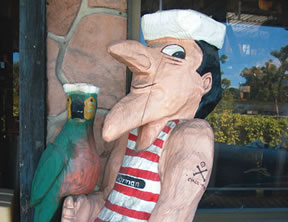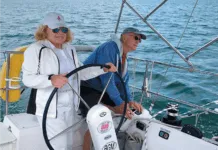
Every now and then, I’ll clear out the attic and come across a shoebox full of receipts and an oil-smeared ledger, testimonies to the steep learning curve we faced when we began outfitting Tosca back in 1989.
Many of the crumpled receipts are illegible; their ink faded with the passage of time. But between the paper scraps and the figures in the ledger, an instructive story emerges. These artifacts of a well-spent youth remind me how we nearly fell into the same trap that keeps so many aspiring voyagers forever tied to the dock.
The glossy rhetoric behind the cruising dream is as intoxicating as any opiate: romantic tales of tropical anchorages, images of crisp white sails under a benevolent blue sky, accounts of marvelous electronics that ensure we’ll never lose our way. It’s no wonder then, that once the dream takes hold, a person doesn’t think twice about paying double the price for something, just because it has “marine” stamped across it.
Most of the oldest receipts in that shoebox come from BoatU.S. or West Marine, whose marine retail empire was expanding across the country. Some of the new purchases—like a new VHF radio—made sense. Others, like the shiny brass oil lamp, were a sure sign of our ignorance. (I found the same lantern months later, lightly used, at half the price.)
Eventually, a wild goose chase for a burner for our Shipmate stove led us to Sailorman, a kind of Disney World for lovers of vintage marine gear in Fort Lauderdale, Fla. At the time, the sprawling used-gear chandlery was loosely staked off into various sections where each sailor could pursue his own eccentric passion. The place we called “Plumbing-land” was stacked with Wilcox-Crittenden Skipper toilets. “Electronics-land” had several pea-green Sailor radio direction finders. Most of Sailorman’s clients were equipping for ocean voyages, so you had to be fast and lucky to find an old Aries windvane in the sprawling back lot, which we eventually dubbed “Heavymetal-land.”
But the real treasures at Sailorman’s, and every used chandlery I’ve visited (and there have been many), are the people behind the counter. Members of the sales staff are often cruising sailors who know from experience what works and what doesn’t. Since fellow sailors are the store’s suppliers as well as their clients, the business of running a used chandlery requires a frankness and flexibility that seem to come from another universe.
I remember buying a $30 brass PAR oil-change pump for $3. “They’re good pumps, but that one probably leaks like a sieve,” the salesman told me. “Bring it back if it doesn’t work.” I was still using that pump for oil changes 10 years later. A pain to clean, but it didn’t leak—well, maybe a little.
But small problems with more important gear can mean big trouble. We ended up learning this the hard way, when the swivel pin sheered on a new stainless-steel bullet block I’d found in the surplus bin. At the time it broke, we were running before a two-day gale off the coast of Colombia.
Oddly enough, the replacement we installed was an antique bronze and ash snatchblock that came from the same store. The lesson from those harrowing few moments bears repeating: When contemplating a piece of equipment—new or used—there is a very fine line between a good buy and “good bye.”





































